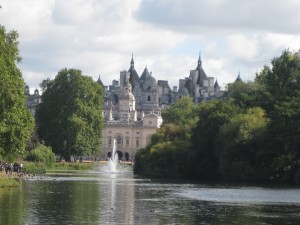Probably because I get a little claustrophobic in cities, my visits to parks have definitely been some of the highlights of my time in London. I enjoyed the sense of space, the people watching, and the sheer beauty of much of the landscaping. However, I did pick up on a certain artificiality throughout London’s Green space.
First of all, the lakes, which are in most cases absolutely beautiful, provide variety in scenery, are home to so many (sometimes exotic looking) species of birds, and they also provide a fun and novel activity for those who choose to rent paddle boats. In St. James Park, the bridge in the middle of the long, central pond is carefully positioned so that visitors can view Buckingham Palace in one direction and the London Eye in the other. The sheer overcrowding of the birds (and their excrement), especially in St. James Park makes me slightly uncomfortable. It seems as though London attempts to make up for the obvious lack of wildlife in the rest of its urban environment by crowding high quantities into small, carefully designated areas. In the “wetlands” area in Regent’s Park, I noticed a rat basking by the water’s edge along side the usual variety of birds. It goes to show I think, that it is impossible to completely keep out the less picturesque aspects of the city.
The gardens that I visited, and especially those in Regents Park were absolutely beautiful. Signs pointed out over twenty different species of roses, and everyone who I saw seemed to walk through slowly. However, when I reflected on how often the grass must be cut, to keep it that short and the precise patterns in which the plants were arranged, the set up seemed more like a human achievement than natural beauty. Hours of work daily clearly go in to maintaining the gardens.
Playgrounds in London’s parks also seemed equally controlled . Every playground that I have seen so far is fenced in, and most do not allow people in unless they have children with them. These playgrounds, which are often large and colorful, must be a welcome refuge to parents who live in the city and are accustomed to having to constantly watch their children in all public places. They definitely reinforce my impression that London makes it a priority to provide leisure space, but only carefully controlled leisure space.
That said, anyone is free to walk into the vast majority of London’s parks. People from all walks of life go there, though it is not a place to interact with strangers. It is socially acceptable to be alone, with large groups of friends or family, or anything in between. In many there is enough space to talk loudly, but I was able to find somewhere quiet in Regents Park to sit and read a book. Maybe all of the control allows for a greater sense of freedom.



1 response so far ↓
hollymb // Sep 20th 2010 at 19:19
I think that you bring up some good points here about artificiality and controlled leisure space, Emily. But it seems to be that the parks almost have to have that artificial feel because they were all created, not just preserved nature. And it seems to go along with Kate Fox’s observations of the English–everything in moderation, and they love gardening!
You must log in to post a comment.